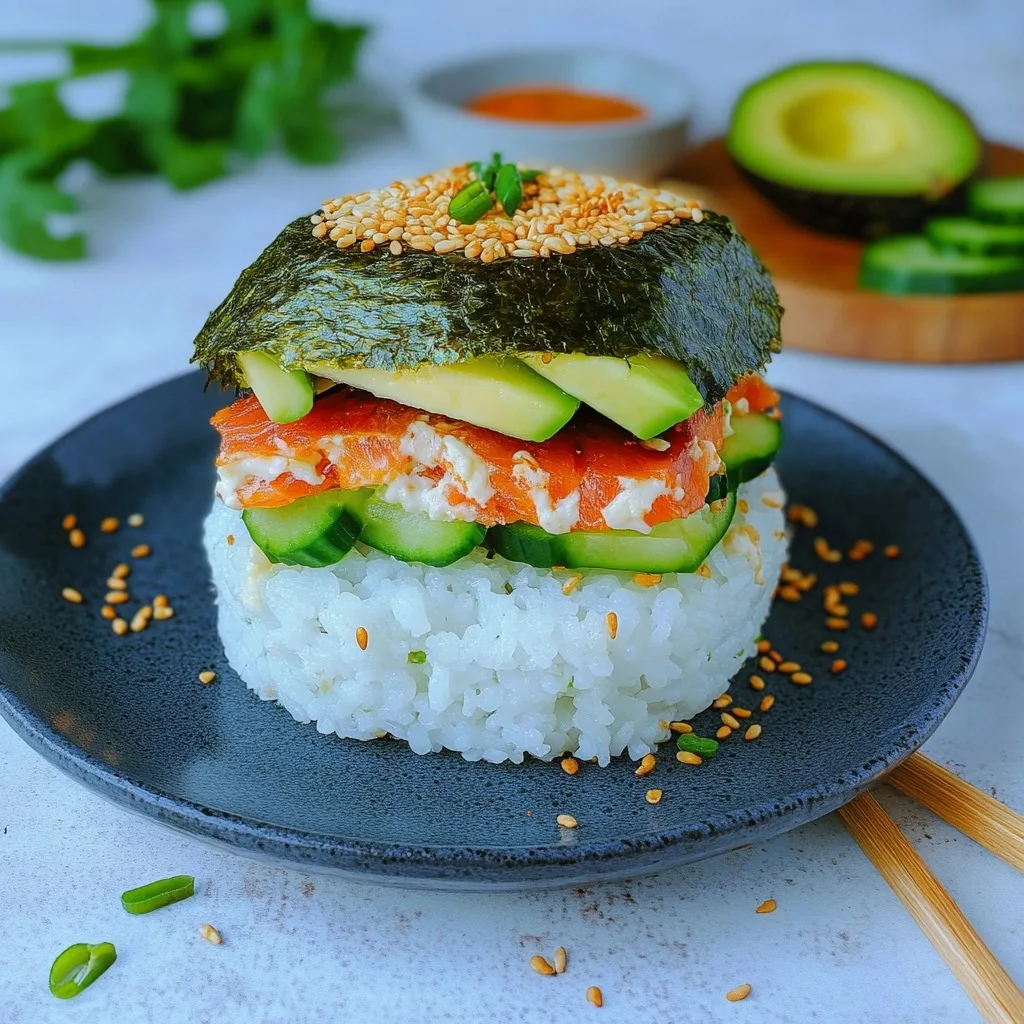Transform your dinner table with this innovative Sushi Burger that combines the delicate flavors of traditional Japanese sushi with the familiar format of an American burger. Perfect for sushi lovers who want to try something new or for those hesitant about raw fish but curious about Japanese cuisine.
Introduction: The Sushi Burger Revolution
When East meets West on your dinner plate, culinary magic happens. The Sushi Burger represents the perfect marriage of Japanese precision and American comfort food, creating a dish that’s both familiar and excitingly new. This innovative creation takes all the beloved elements of sushi—seasoned rice, fresh seafood, crisp vegetables, and umami-rich accompaniments—and reimagines them in burger form.
Unlike traditional sushi that requires special rolling techniques, the Sushi Burger is approachable for home cooks of all skill levels. The crispy rice “buns” provide a satisfying crunch that gives way to the tender filling inside, while the presentation creates an Instagram-worthy dish that’s sure to impress friends and family alike.
Whether you’re hosting a dinner party, looking for a fun weekend cooking project, or simply wanting to elevate your weeknight meals, the Sushi Burger delivers on all fronts. It maintains the healthy aspects of sushi while adding a playful twist that even sushi skeptics can embrace. The best part? You can customize every element to suit your taste preferences and dietary needs.
In this comprehensive guide, I’ll walk you through everything you need to know to create perfect Sushi Burgers at home—from selecting the freshest ingredients to mastering the crispy rice buns and assembling your masterpiece. Let’s dive into this delicious fusion adventure!
Essential Ingredients for the Perfect Sushi Burger
Selecting and Preparing the Rice “Buns”
The foundation of any great Sushi Burger starts with perfectly cooked and seasoned sushi rice. This isn’t just any rice—it’s a short-grain Japanese variety that becomes sticky when cooked, allowing it to hold its shape when formed into “buns.”
Rice selection: Look specifically for rice labeled “sushi rice” or “short-grain Japanese rice.” Brands like Nishiki, Kokuho Rose, or Tamaki Gold are excellent choices. The higher starch content is crucial for creating buns that won’t fall apart.
Washing technique: Don’t skip the rinsing step! This removes excess starch that can make your rice gummy. Place the rice in a large bowl, cover with cold water, swish gently with your hands, then drain. Repeat this process 3-4 times until the water runs relatively clear.
Perfect cooking ratio: The 3 cups of rice to 3½ cups water ratio in our recipe creates the ideal texture—tender but not mushy. Using a heavy-bottomed pot with a tight-fitting lid ensures even cooking and proper steam retention.
Seasoning secrets: The vinegar mixture (often called “sushi su”) is what transforms plain rice into sushi rice. The balance of rice vinegar, sugar, and salt adds the signature tangy-sweet flavor that makes sushi so distinctive. This seasoning should be folded in while the rice is still warm for optimal absorption.
Selecting Quality Fish and Seafood
The star protein in your Sushi Burger deserves special attention:
Sushi-grade standards: When using raw fish in your Sushi Burger, it’s essential to purchase “sushi-grade” or “sashimi-grade” fish from a reputable fishmonger or Japanese market. This designation means the fish has been frozen to specific temperatures to eliminate potential parasites.
Freshness indicators: Look for fish with a clean ocean smell (never fishy), firm texture, and vibrant color. For salmon, look for bright orange-pink flesh; for tuna, seek deep red color without brown edges.
Alternative proteins: If you’re hesitant about raw fish, consider these delicious alternatives:
- Cooked and chilled shrimp
- Seared and thinly sliced tuna
- Imitation crab (surimi)
- Smoked salmon
- Grilled teriyaki chicken for a completely different twist
- Marinated tofu for a vegetarian option
Storage tips: Keep sushi-grade fish extremely cold until ready to use, ideally in the coldest part of your refrigerator on a bed of ice. Use within 24 hours of purchase for optimal freshness and safety.
Fresh Vegetables and Accompaniments
The supporting cast of ingredients adds texture, color, and nutritional value:
Avocado selection: Choose avocados that yield slightly to gentle pressure—not too firm and not too soft. For the perfect slices, look for fruit that’s just reached ripeness.
Cucumber varieties: Japanese or Persian cucumbers work best due to their thin skin, minimal seeds, and crisp texture. If unavailable, English cucumbers make a good substitute.
Pickled ginger purpose: Beyond being a palate cleanser, pickled ginger (gari) adds brightness and acidity to the Sushi Burger. The pink variety is colored with natural beet juice and has a milder flavor than the yellow type.
Nori quality: Look for sheets that are shiny, dark green-black, and crisp. Store unopened packages in a cool, dry place, and once opened, keep them in an airtight container with a desiccant packet to maintain crispness.
Sesame seeds: Toasting sesame seeds awakens their nutty flavor. Do this in a dry skillet over medium heat for 2-3 minutes, shaking frequently until golden and fragrant.
By focusing on quality ingredients and proper preparation techniques, you’ll build a solid foundation for Sushi Burgers that taste as good as they look!
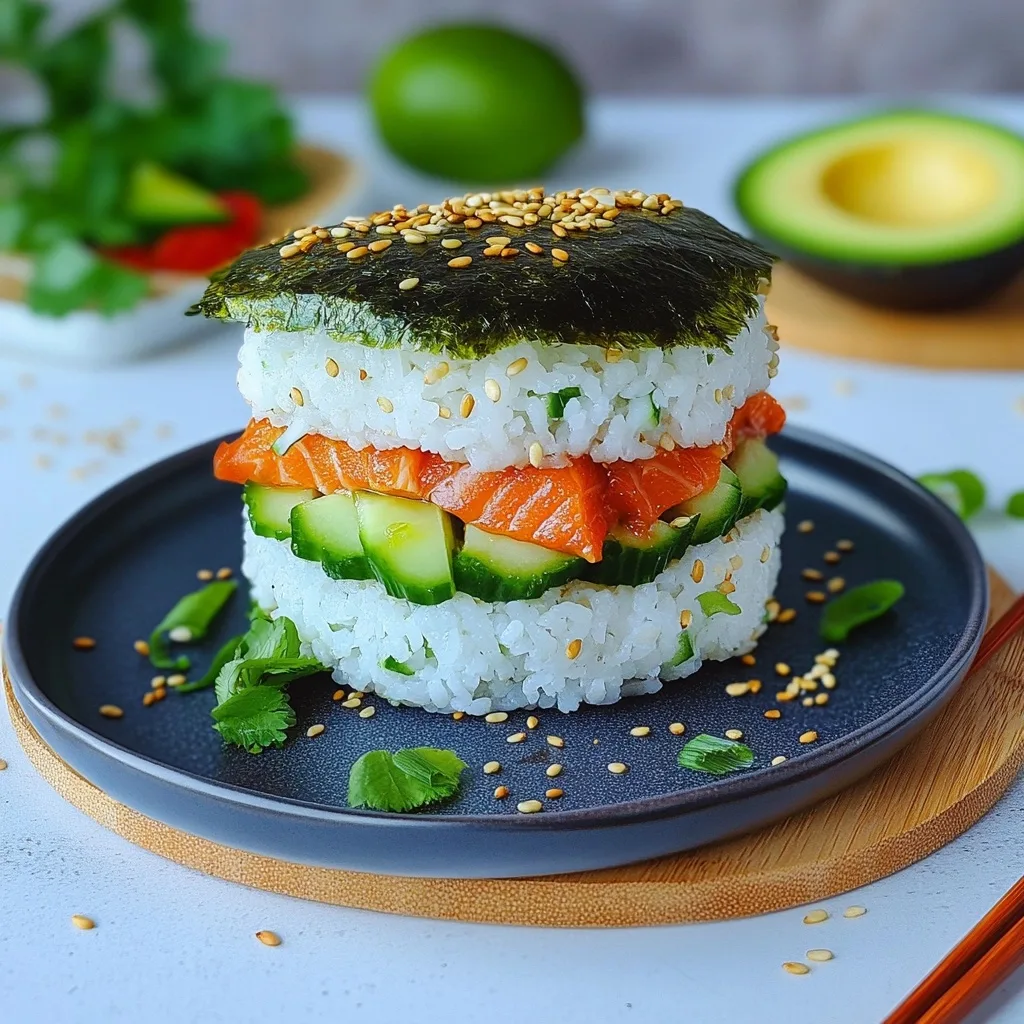
Step-by-Step Sushi Burger Creation
Mastering the Rice “Buns”
Creating the perfect rice buns requires attention to detail, but the results are worth it:
- Precise measuring: Use the ¾ cup measurement consistently for each bun to ensure they’re all the same size and cook evenly.
- Compacting technique: When packing rice into measuring cups, press firmly with the back of a moistened spoon. This compression is crucial—too loose, and your buns will fall apart; too compact, and they’ll be dense and chewy.
- Unmolding trick: Wet your fingers slightly before handling the rice to prevent sticking. When unmolding, flip the measuring cup onto parchment paper and tap the bottom firmly. If it sticks, run a thin knife around the edge.
- The perfect sear: The sesame oil adds flavor while preventing sticking. Keep the heat at medium—too high and the outside will burn before the bun develops the necessary crust for structural integrity. Look for a golden color and listen for a slight sizzle.
- Resting period: Allow the rice buns to cool for 5 minutes after cooking. This cooling period helps them firm up further, making assembly easier and reducing the chance of breakage.
For extra flavor and visual appeal, consider mixing black sesame seeds into half of your rice for two-toned buns, or adding a sprinkle of furikake (Japanese rice seasoning) to the exterior before cooking.
Creating the Perfect Spicy Mayo
This simple but essential sauce brings creamy heat to your Sushi Burger:
- Start with high-quality mayonnaise—Kewpie (Japanese mayonnaise) offers unparalleled creaminess and a hint of umami, but any good quality mayo works well.
- When adding Sriracha, start with less than you think you need and taste as you go. The heat level can intensify as the sauce sits.
- For extra flavor dimension, add a few drops of toasted sesame oil and a squeeze of lime juice to your spicy mayo.
- Store any leftover sauce in an airtight container in the refrigerator for up to one week—it makes an excellent dipping sauce for vegetables or spread for sandwiches.
The ideal spicy mayo should have a vibrant orange-pink color and a consistency that’s thick enough to stay put on your Sushi Burger but soft enough to spread easily.
Assembly Techniques for a Picture-Perfect Sushi Burger
Building your Sushi Burger is where artistry meets architecture:
- Strategic layering: Start with a solid base by placing your first rice bun flat-side up. This provides a stable foundation.
- Moisture barrier: The layer of nori is crucial for preventing the rice from getting soggy from the filling’s moisture. Trim it to fit neatly within the circumference of the rice bun.
- Fish placement: Arrange the fish in a slightly overlapping pattern, keeping it away from the very edges to prevent it from sliding out when bitten.
- Color consideration: Layer your components with visual appeal in mind—the vibrant green avocado contrasts beautifully with the pink fish and white rice.
- Structural integrity: When adding the top bun, press down gently but firmly to compress the filling just enough to make it stable without squishing everything out the sides.
- Final touch: A sprinkle of black and white sesame seeds on top adds visual interest and a subtle nuttiness.
For a professional presentation, place a colorful garnish like a small shiso leaf or microgreens alongside the burger, and serve on a minimalist plate or bamboo board to let your Sushi Burger take center stage.
Creative Variations and Adaptations
Regional Sushi Burger Inspirations
The beauty of the Sushi Burger lies in its adaptability to different flavor profiles:
California-Style Sushi Burger: Replace the salmon or tuna with surimi (imitation crab), add thinly sliced avocado, cucumber, and a sprinkle of tobiko (flying fish roe) for color and pop.
Spicy Tuna Sushi Burger: Mix diced sushi-grade tuna with spicy mayo and chopped scallions for the filling, then add thin slices of jalapeño for extra heat.
Philadelphia-Style Sushi Burger: Layer smoked salmon with cream cheese, thinly sliced cucumber, and fresh dill for a bagel-inspired variation.
Hawaii-Inspired Sushi Burger: Top with cubes of fresh pineapple marinated in soy sauce, diced raw tuna, sliced jalapeño, and a sprinkle of macadamia nuts for a poke-inspired experience.
New York Roll Burger: Fill with fresh salmon, thin apple slices, and avocado, then drizzle with spicy mayo for a creative take on this popular roll.
Each variation celebrates different regional sushi traditions while maintaining the innovative burger format.
Vegetarian and Vegan Adaptations
Plant-based eaters can enjoy Sushi Burgers too:
Vegetarian fillings:
- Sliced avocado and cucumber with Japanese-style egg omelet (tamagoyaki)
- Grilled portobello mushroom marinated in soy sauce, mirin, and ginger
- Tempura sweet potato with avocado and microgreens
- Pickled daikon and carrot with fresh cucumber and avocado
Vegan considerations:
- Replace mayo-based sauces with avocado-based spreads or vegan mayonnaise mixed with Sriracha
- Try smoked tofu marinated in soy sauce, rice vinegar, and a touch of liquid smoke
- Consider adding roasted seaweed snacks for extra umami flavor
- Incorporate protein with edamame mashed with a bit of sesame oil and salt
These adaptations ensure that everyone at your table can enjoy the fun and flavors of Sushi Burgers, regardless of dietary preferences.
Creative Serving Suggestions
Elevate your Sushi Burger experience with these presentation ideas:
Deconstructed style: Serve the components separately and let guests build their own Sushi Burgers for an interactive dining experience.
Mini sliders: Create bite-sized versions using smaller rice molds for perfect party appetizers.
Wrapped option: For easier eating, wrap the assembled burger in nori or soy paper like a burrito.
Bowl alternative: Arrange all components in a bowl for a Sushi Burger bowl—all the flavors without the structural challenges.
Family-style platter: Create a giant Sushi Burger for the center of the table and slice it like a cake for sharing.
These serving variations maintain the essence of the Sushi Burger while adapting to different dining scenarios.
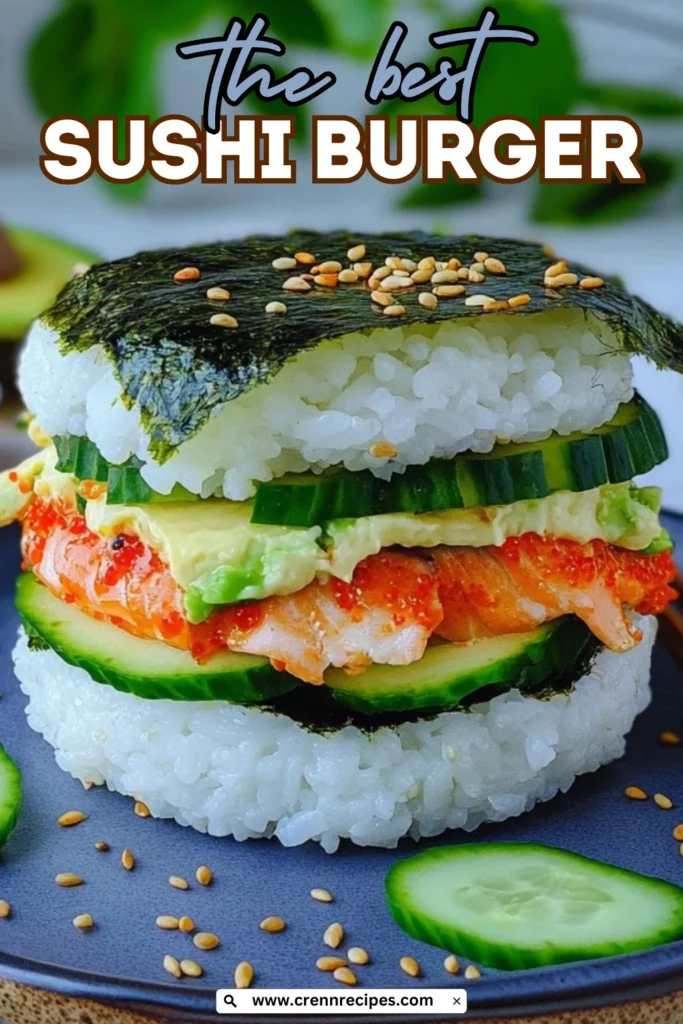
Nutritional Benefits and Dietary Considerations
The Health Advantages of Sushi Burgers
This fusion creation brings together multiple nutritional benefits:
Omega-3 rich seafood: The salmon or tuna in Sushi Burgers provides heart-healthy omega-3 fatty acids, which support brain health and reduce inflammation.
Whole grain goodness: Sushi rice, especially when mixed with brown rice, offers complex carbohydrates and more fiber than traditional burger buns.
Nutrient-dense vegetables: The avocado delivers healthy monounsaturated fats and potassium, while cucumber adds hydration and fiber with minimal calories.
Seaweed benefits: Nori contains iodine, which supports thyroid function, along with vitamins A, C, and E.
Lower calorie option: A typical Sushi Burger contains approximately 350-450 calories—significantly less than most traditional burgers.
Balanced macronutrients: The combination of carbohydrates from rice, protein from fish, and healthy fats from avocado and fish creates a well-rounded meal.
When compared to both traditional sushi rolls and conventional burgers, the Sushi Burger offers a balanced middle ground that incorporates the best nutritional aspects of both.
Adapting for Dietary Restrictions
With minor modifications, Sushi Burgers can accommodate various dietary needs:
Gluten-free adaptation: Traditional Sushi Burgers are naturally gluten-free, but always check soy sauce and other condiments for hidden gluten. Use tamari instead of regular soy sauce to be safe.
Low-carb options: Replace half or all of the rice with cauliflower rice seasoned with rice vinegar, sugar, and salt. For a completely rice-free version, try thin slices of roasted sweet potato as the “buns.”
Sodium considerations: Reduce sodium by using less soy sauce and opting for fresh fish rather than smoked varieties. You can also rinse the pickled ginger to remove some of the salt.
Allergen awareness:
- Fish allergies: Substitute with cooked chicken, beef, or tofu
- Shellfish concerns: Avoid cross-contamination when purchasing fish
- Sesame allergies: Omit sesame oil and seeds, using olive oil instead for cooking
By making thoughtful substitutions, Sushi Burgers can become an inclusive meal option that respects dietary restrictions without sacrificing flavor.
Pairing Suggestions and Complete Meal Ideas
Traditional and Fusion Beverage Pairings
Complement your Sushi Burger with these carefully selected beverages:
Traditional Japanese options:
- Chilled sake, particularly a light, fruit-forward variety like Ginjo
- Green tea, served hot or cold
- Asahi or Sapporo beer for a refreshing counterpoint
Fusion-inspired choices:
- Cucumber-infused water or lemonade
- Yuzu-flavored sparkling water
- Ginger kombucha for probiotic benefits and complementary flavor
- Lychee or passionfruit iced tea
Non-alcoholic specialties:
- Calpico (a Japanese yogurt-based soft drink)
- Ramune (Japanese soda with distinctive marble seal)
- Matcha latte, hot or iced
The ideal beverage should cleanse the palate between bites without overwhelming the delicate flavors of the Sushi Burger.
Side Dishes That Complement Sushi Burgers
Create a complete meal with these harmonious accompaniments:
Traditional sides:
- Edamame sprinkled with sea salt
- Miso soup with silken tofu and wakame seaweed
- Simple cucumber salad with rice vinegar dressing
- Seaweed salad with sesame dressing
Fusion-inspired accompaniments:
- Sweet potato fries with wasabi aioli
- Tempura vegetables with ponzu dipping sauce
- Asian slaw with ginger-sesame dressing
- Avocado fries with spicy mayo
For a dinner party, consider creating a tasting menu with mini Sushi Burgers paired with small portions of various side dishes for an interactive dining experience.
Dessert Pairings to Complete the Meal
Finish your Japanese-American fusion experience with these complementary desserts:
Light options:
- Mochi ice cream in green tea, mango, or strawberry flavors
- Fresh fruit salad with yuzu or lychee syrup
- Japanese cotton cheesecake
More decadent choices:
- Matcha tiramisu
- Black sesame ice cream
- Tempura fried ice cream with caramel drizzle
These dessert options maintain the East-meets-West theme while providing a satisfying conclusion to your Sushi Burger meal.
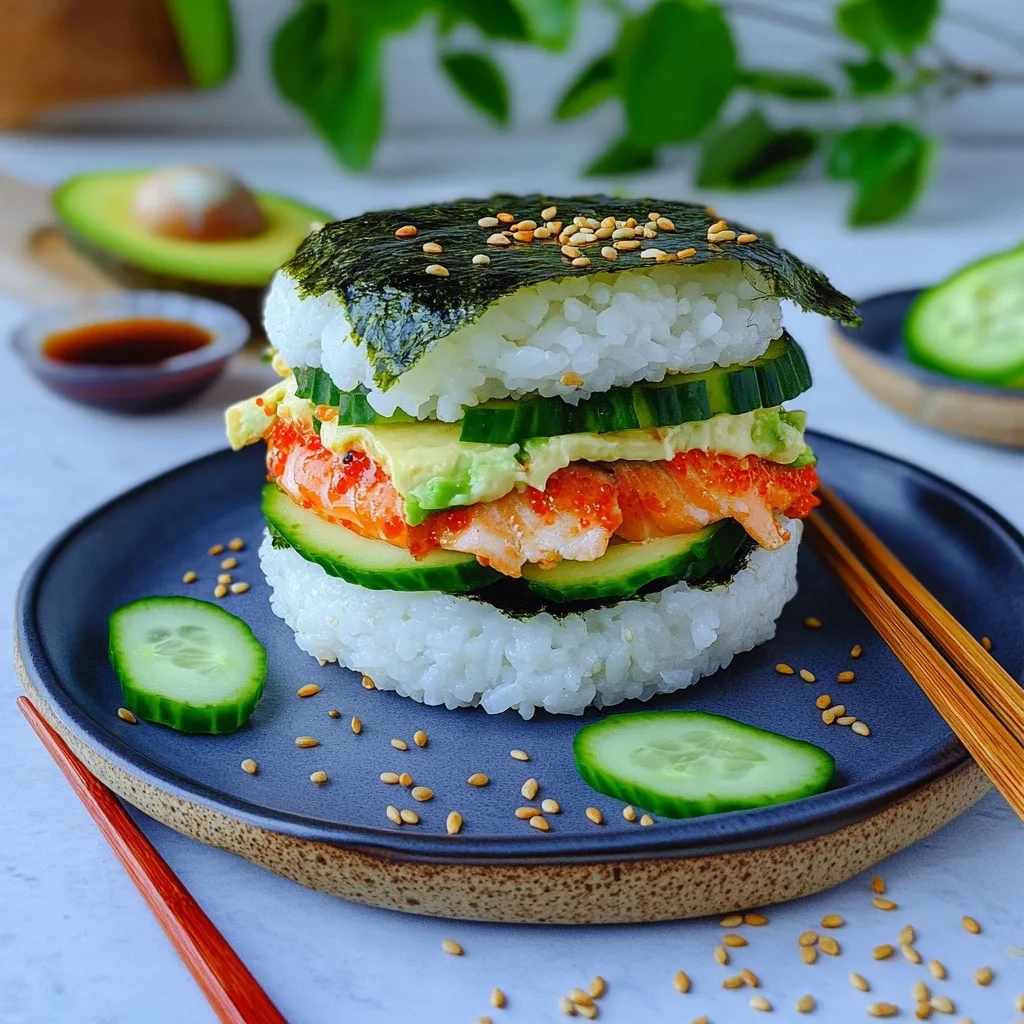
Frequently Asked Questions About Sushi Burgers
Q1: Is it safe to use raw fish in Sushi Burgers?
When purchasing fish for Sushi Burgers (or any raw fish preparation), buy only from reputable sources that specifically sell “sushi-grade” or “sashimi-grade” fish. This designation means the fish has been frozen according to FDA guidelines to kill potential parasites. Keep the fish refrigerated at all times and use within 24 hours of purchase. If you’re pregnant, elderly, very young, or immunocompromised, consider fully cooking your fish or using cooked alternatives like shrimp or crab.
Q2: Why won’t my rice buns hold their shape?
Several factors can affect rice cohesion. First, ensure you’re using short-grain Japanese sushi rice—long-grain varieties won’t stick together properly. Second, the vinegar seasoning is crucial as it adds stickiness. Third, pack the rice firmly into the measuring cups, pressing down with a spoon. Finally, allowing the cooked rice buns to cool slightly before handling helps them firm up. If you’re still having trouble, try adding a tablespoon of cornstarch to your rice or reducing the water slightly when cooking.
Q3: Can I make Sushi Burgers ahead of time?
You can prepare components in advance, but assembled Sushi Burgers are best enjoyed immediately. The rice buns can be made up to four hours ahead and kept at room temperature, covered with a slightly damp cloth. The spicy mayo and cut vegetables can be refrigerated overnight. For best results, assemble just before serving to prevent the nori from becoming soggy and the rice from hardening in the refrigerator.
Q4: How do I eat a Sushi Burger without it falling apart?
The Sushi Burger is admittedly a bit messier than traditional sushi! Try wrapping the bottom half in parchment paper or nori before eating, similar to how you’d eat a regular burger. Alternatively, slice it in half for easier handling. Some people prefer to eat Sushi Burgers with chopsticks and a fork, deconstructing it slightly as they go. There’s no wrong approach—embrace the beautiful mess!
Q5: What’s the best rice-to-filling ratio for Sushi Burgers?
The ideal ratio is approximately 2:1 rice to filling. Each rice bun should be about ¾-inch thick, with about 1½ inches of total filling height. Too much filling makes the burger difficult to eat, while too little loses the textural contrast that makes Sushi Burgers special. Remember that you can always serve extra fillings on the side for those who want more.
Q6: Can I use brown rice for a healthier Sushi Burger?
Yes, you can substitute brown sushi rice, though it requires some adjustments. Brown rice needs more water (about ¼ cup extra per 3 cups rice) and longer cooking time (45-50 minutes). Since it’s less sticky than white rice, add 1 tablespoon of cornstarch to your seasoned rice to help it hold together. You might also try a 50/50 mix of brown and white sushi rice for a nutritional boost while maintaining the necessary stickiness.
Conclusion: Embracing the Sushi Burger Experience
The Sushi Burger represents the beautiful evolution of culinary traditions—a respectful fusion that honors Japanese techniques while embracing the playful format of American cuisine. It transforms the sometimes intimidating art of sushi-making into an approachable, customizable experience that brings people together around the table.
Beyond its impressive presentation and delicious flavor profile, the Sushi Burger offers a conversation starter—a dish that encourages diners to engage with their food and each other. It’s perfect for introducing hesitant eaters to Japanese flavors through a familiar format, and for giving sushi enthusiasts a new way to enjoy their favorite ingredients.
Whether you follow our recipe exactly or use it as inspiration for your own creative variations, the Sushi Burger invites culinary exploration and personal expression. It reminds us that cooking is as much about joy and connection as it is about nourishment.
So gather your ingredients, invite some friends, and embrace the adventure of creating these eye-catching Sushi Burgers. The process is as rewarding as the result—and the memories made around your table will last long after the last bite is enjoyed.
More Related Recipes You Might Enjoy
If you enjoyed this Sushi Burger recipe, you might also like these complementary dishes that share similar ingredients, techniques, or fusion concepts:
- Watermelon Sorbet – A refreshing palate cleanser that pairs beautifully with Asian-inspired meals and provides a cool contrast after the savory Sushi Burger.
- Sushi Pizza – Another creative sushi fusion recipe that transforms traditional Japanese ingredients into an accessible, shareable format—perfect for those who loved the innovative approach of the Sushi Burger.
- Peppermint Bark Butterfinger Candy Bars – For a sweet finish to your fusion meal, these candy bars represent another successful blend of different flavor traditions in one delightful package.
Try these recipes to expand your culinary horizons and continue your journey through creative fusion cuisine!
Print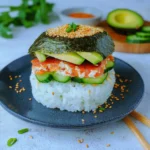
Sushi Burger Recipe: 7 Amazing Secrets for Irresistible Results
- Total Time: 60 minutes
- Yield: 4 sushi burgers 1x
Description
A stunning fusion dish that combines the delicate flavors of Japanese sushi with the format of an American burger. These Sushi Burgers feature crispy sushi rice “buns” filled with fresh salmon, avocado, cucumber, and topped with nori seaweed and sesame seeds – perfect for impressing guests or elevating your family dinner.
Ingredients
- 3 cups sushi rice, rinsed until water runs clear
- 3½ cups water
- 4 tablespoons rice vinegar
- 2 tablespoons sugar
- 1 teaspoon salt
- 1 tablespoon sesame oil (for cooking the buns)
- 8 ounces sushi-grade salmon or tuna, thinly sliced
- 4 sheets nori (seaweed), cut in half
- 1 avocado, thinly sliced
- 1 small cucumber, julienned
- ¼ cup pickled ginger, drained
- 2 tablespoons toasted sesame seeds
- 4 tablespoons spicy mayo
- 2 tablespoons unseasoned mayo
- 1 tablespoon Sriracha (adjust to taste)
Instructions
- In a medium pot, combine rinsed sushi rice and 3½ cups water. Bring to a boil, then reduce heat to low, cover, and simmer 18–20 minutes until water’s absorbed. Remove from heat and let rest, covered, 10 minutes.
- In a small bowl, whisk rice vinegar, sugar, and salt until dissolved. Gently fold into the warm rice with a wooden spoon, taking care not to mash the grains. Spread the rice on a tray to cool slightly.
- Lightly oil four ½-cup measuring cups or small ramekins with sesame oil. Pack each with about ¾ cup of seasoned rice, pressing firmly to form a tight patty. Unmold onto a sheet of parchment.
- Heat a nonstick skillet over medium heat and add a tiny brush of sesame oil. Gently fry each rice patty 2–3 minutes per side until golden and crisp. Transfer to a plate lined with paper towels.
- In a small bowl, whisk together the mayo and Sriracha to make spicy mayo. Taste and adjust heat as desired.
- To assemble: Place one rice bun flat-side up. Spread 1 tablespoon spicy mayo evenly across the rice.
- Place a sheet of nori over the mayo (it helps keep the rice from getting soggy).
- Layer on a few slices of salmon or tuna, then avocado, cucumber, and a bit of pickled ginger. Sprinkle with sesame seeds.
- Drizzle with an extra dab of spicy mayo if desired, then top with the second rice bun. Press down gently.
- Repeat for remaining burgers, then slice in half for easier eating or serve whole.
Notes
- For best results, use short-grain Japanese sushi rice, which has the right stickiness to form stable buns.
- If you’re concerned about using raw fish, substitute with smoked salmon, cooked shrimp, or even teriyaki chicken.
- The rice buns can be made a few hours ahead and kept at room temperature under a slightly damp cloth.
- For easier eating, wrap the bottom half of the burger in parchment paper.
- Customize with your favorite sushi fillings – crab, shrimp, or tofu all work well.
- Prep Time: 30 minutes
- Cook Time: 30 minutes
- Category: Main Dish
- Method: Stovetop
- Cuisine: Fusion, Japanese
Nutrition
- Serving Size: 1 sushi burger
- Calories: 420
- Sugar: 5g
- Sodium: 480mg
- Fat: 15g
- Saturated Fat: 2.5g
- Unsaturated Fat: 11.5g
- Trans Fat: 0g
- Carbohydrates: 58g
- Fiber: 4g
- Protein: 14g
- Cholesterol: 35mg

